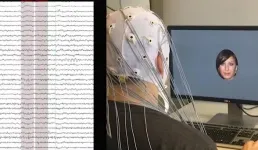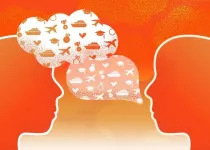Beauty is in the brain: AI reads brain data, generates personally attractive images
Researchers have succeeded in making an AI understand our subjective notions of what makes faces attractive
2021-03-05
(Press-News.org) Researchers have succeeded in making an AI understand our subjective notions of what makes faces attractive. The device demonstrated this knowledge by its ability to create new portraits on its own that were tailored to be found personally attractive to individuals. The results can be utilised, for example, in modelling preferences and decision-making as well as potentially identifying unconscious attitudes.
Researchers at the University of Helsinki and University of Copenhagen investigated whether a computer would be able to identify the facial features we consider attractive and, based on this, create new images matching our criteria. The researchers used artificial intelligence to interpret brain signals and combined the resulting brain-computer interface with a generative model of artificial faces. This enabled the computer to create facial images that appealed to individual preferences.
"In our previous studies, we designed models that could identify and control simple portrait features, such as hair colour and emotion. However, people largely agree on who is blond and who smiles. Attractiveness is a more challenging subject of study, as it is associated with cultural and psychological factors that likely play unconscious roles in our individual preferences. Indeed, we often find it very hard to explain what it is exactly that makes something, or someone, beautiful: Beauty is in the eye of the beholder," says Senior Researcher and Docent Michiel Spapé from the Department of Psychology and Logopedics, University of Helsinki.
The study, which combines computer science and psychology, was published in February in the IEEE Transactions in Affective Computing journal.
Preferences exposed by the brain
Initially, the researchers gave a generative adversarial neural network (GAN) the task of creating hundreds of artificial portraits. The images were shown, one at a time, to 30 volunteers who were asked to pay attention to faces they found attractive while their brain responses were recorded via electroencephalography (EEG).
"It worked a bit like the dating app Tinder: the participants 'swiped right' when coming across an attractive face. Here, however, they did not have to do anything but look at the images. We measured their immediate brain response to the images," Spapé explains.
The researchers analysed the EEG data with machine learning techniques, connecting individual EEG data through a brain-computer interface to a generative neural network.
"A brain-computer interface such as this is able to interpret users' opinions on the attractiveness of a range of images. By interpreting their views, the AI model interpreting brain responses and the generative neural network modelling the face images can together produce an entirely new face image by combining what a particular person finds attractive," says Academy Research Fellow and Associate Professor Tuukka Ruotsalo, who heads the project.
To test the validity of their modelling, the researchers generated new portraits for each participant, predicting they would find them personally attractive. Testing them in a double-blind procedure against matched controls, they found that the new images matched the preferences of the subjects with an accuracy of over 80%.
"The study demonstrates that we are capable of generating images that match personal preference by connecting an artificial neural network to brain responses. Succeeding in assessing attractiveness is especially significant, as this is such a poignant, psychological property of the stimuli. Computer vision has thus far been very successful at categorising images based on objective patterns. By bringing in brain responses to the mix, we show it is possible to detect and generate images based on psychological properties, like personal taste," Spapé explains.
Potential for exposing unconscious attitudes
Ultimately, the study may benefit society by advancing the capacity for computers to learn and increasingly understand subjective preferences, through interaction between AI solutions and brain-computer interfaces.
"If this is possible in something that is as personal and subjective as attractiveness, we may also be able to look into other cognitive functions such as perception and decision-making. Potentially, we might gear the device towards identifying stereotypes or implicit bias and better understand individual differences," says Spapé.
INFORMATION:
Further information:
Michiel Spapé (contacts in English)
Senior researcher, Department of Psychology and Logopedics, University of Helsinki
michiel.spape@helsinki.fi
+358 50 556 0398
Tuukka Ruotsalo
Academy research fellow, Department of Computer Science, University of Helsinki
Associate professor, Department of Computer Science, University of Copenhagen
tuukka.ruotsalo@helsinki.fi
+358 50 566 1400
VIdeo Abstract: Brain-computer interface for generating personally attractive images
[Attachments] See images for this press release:

ELSE PRESS RELEASES FROM THIS DATE:
2021-03-05
Researchers from University of Houston and University of Bochum published a new paper in the Journal of Marketing that examines how variable compensation plans for salespeople can lead to lower health.
The study, forthcoming in the Journal of Marketing, is titled "Variable Compensation and Salesperson Health" and is authored by Johannes Habel, Sascha Alavi, and Kim Linsenmayer.
Sales compensation plans typically comprise a variable component. Variable compensation is issued on top of a base salary and the amount is contingent on performance. For example, a salesperson with an annual target salary ...
2021-03-05
New research published in Diabetologia (the journal of the European Association for the Study of Diabetes [EASD]) shows that regular physical activity is a safe diabetes prevention strategy for people residing in relatively polluted regions.
The study, which is the first to investigate the combined effects of physical activity and pollution exposure on type 2 diabetes risk, is by Dr Cui Guo and Professor Lao Xiang Qian, Faculty of Medicine at the Chinese University of Hong Kong, Hong Kong SAR, China, and Dr Hsiao Ting Yang, Institute for Risk Assessment Sciences, Utrecht University, Utrecht, the Netherlands, and colleagues.
An increasing body of evidence has shown that air pollution ...
2021-03-04
A series of weekend workshops that integrate strategies for both reducing risky alcohol use and preventing sexually transmitted infections (STIs) led to an increase in safe sex and decrease in drinking among young Black women, according to a new study published in the American Journal of Preventive Medicine.
"By designing an intervention that didn't treat sex and alcohol use as two separate risk factors, young women were empowered to make healthier decisions and better communicate with their partners," said Ralph DiClemente, professor and chair of the Department of Social and Behavioral Sciences at NYU School of Global Public Health and the study's lead author.
"This groundbreaking study illustrates ...
2021-03-04
Columbia researchers engineer first technique to exploit the tunable symmetry of 2D materials for nonlinear optical applications, including laser, optical spectroscopy, imaging, and metrology systems, as well as next-generation optical quantum information processing and computing.
New York, NY--March 4, 2021--Nonlinear optics, a study of how light interacts with matter, is critical to many photonic applications, from the green laser pointers we're all familiar with to intense broadband (white) light sources for quantum photonics that enable optical quantum computing, super-resolution imaging, optical sensing and ranging, and more. Through nonlinear optics, researchers are discovering new ways to use light, from getting a closer look at ultrafast processes in physics, ...
2021-03-04
A new study reveals that a precarious, unstable initiation by young people to working life is associated with poorer future mental health. The study was conducted by researchers from the Center for Research in Occupational Health (CISAL, a joint group of UPF and the Hospital del Mar Medical Research Institute) in Barcelona, Spain. Amaya Ayala-Garcia, Laura Serra and Mònica Ubalde-López are the authors of the study, which has been published in the journal BMJ Open.
Since the 1990s, Spain has been among the European countries with the lowest employment rates, which are accentuated in the young active population. Moreover, in 2017, Spain ...
2021-03-04
March 4, 2021 -- Pandemic-related anxiety, boredom, and irregular routines were cited as major drivers of increased nicotine and tobacco use during the initial COVID-19 "lockdown," according to research just released by Columbia University's Mailman School of Public Health. The study highlights ways that public health interventions and policies can better support quit attempts and harm reduction, both during the COVID-19 pandemic and beyond. The findings are published in the International Journal of Drug Policy.
Between April-May 2020, the researchers conducted ...
2021-03-04
CLEVELAND (March 5, 2021)--An international team of bioethicists and scientists, led by a researcher at Case Western Reserve University, contends it may be justified to go beyond the standing 14-day limit that restricts how long researchers can study human embryos in a dish. Going beyond this policy limit could lead to potential health and fertility benefits, and the authors provide a process for doing so.
In an article published March 5 in Science, Insoo Hyun, a bioethics professor at the Case Western Reserve University School of Medicine and the paper's lead author, and colleagues urge policymakers and the International Society for Stem Cell Research (ISSCR) to consider "a cautious, stepwise approach" to scientific exploration beyond the 14-day limit.
"But first," ...
2021-03-04
Did you daydream as a kid, maybe even get in trouble for it? If you find it harder to be pleasantly lost in your thoughts these days, you're not alone.
"This is part of our cognitive toolkit that's underdeveloped, and it's kind of sad," said Erin Westgate, Ph.D., a University of Florida psychology professor.
The ability to think for pleasure is important, and you can get better at it, Westgate says. The first step is recognizing that while it might look easy, daydreaming is surprisingly demanding.
"You have to be the actor, director, screenwriter and audience of a mental performance," she said. "Even though it looks like you're doing nothing, it's cognitively ...
2021-03-04
ITHACA, N.Y. - Close friends are important drivers of adolescent behavior, including college attendance, according to Steven Alvarado, assistant professor of sociology in the College of Arts and Sciences.
In new research published March 4 in American Educational Research Journal, Alvarado reports that having college-bound friends increases the likelihood that a student will enroll in college. However, the effect of having college-bound friends is diminished for Black and Latino students compared with white and Asian students, especially for males and especially for selective and highly selective colleges, due to structural ...
2021-03-04
Ever get stuck trying to solve a puzzle?
You look for a pattern, or a rule, and you just can't spot it. So you back up and start over.
That's your brain recognizing that your current strategy isn't working, and that you need a new way to solve the problem, according to new research from the University of Washington. With the help of about 200 puzzle-takers, a computer model and functional MRI (fMRI) images, researchers have learned more about the processes of reasoning and decision-making, pinpointing the brain pathway that springs into action when problem-solving ...
LAST 30 PRESS RELEASES:
[Press-News.org] Beauty is in the brain: AI reads brain data, generates personally attractive images
Researchers have succeeded in making an AI understand our subjective notions of what makes faces attractive




